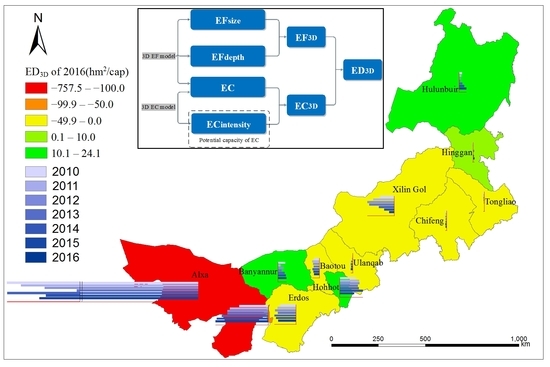| Location: Home > Papers |
| First Author: | WANG Yening |
| Abstract: | Under the concept of green development, accurately mapping ecological carrying capacity to effectively evaluate regional sustainability has already become an important issue in China. This study introduced ecological carrying capacity intensity (ECintensity) based on the revised three-dimensional ecological footprint (3DEF) model to describe the temporal–spatial patterns of three-dimensional ecological carrying capacity (EC3D) in Inner Mongolia in 2010–2016 and to explore factors affecting socioeconomic sustainable development. The results showed that ecological footprint size (EFsize) differed between cities/leagues but changed little during the study period. Ecological footprint depth (EFdepth) far exceeded the original value of 1.00. Ecological carrying capacity (EC) varied in cities/leagues, while ECintensity increased slowly with stronger potential for regional development. Three-dimensional ecological deficits (ED3D) of cities/leagues were divided into five categories: Hohhot, Hulunbuir and Banyannur were in larger ecological surplus; Hinggan was in slight surplus; Baotou, Chifeng, Tongliao, Ulanqab, Xilin Gol and Erdos were in slight deficit; Wuhai was in stronger deficit; and Alxa was in severely intense deficit. Woodland of cities/leagues was continuously in slight ecological surplus, while cropland and grassland had crucial impacts on deficit. There was a significant positive linear correlation between gross domestic product (GDP) and footprint, while a negative correlation was seen with deficit. These results would help coordinate resource utilization and industrial structure adjustment in Inner Mongolia.
|
| Contact the author: | WANG Haowei |
| Page Number: | |
| Issue: | 7 |
| Subject: | |
| Impact Factor: | |
| Authors units: | |
| PubYear: | APR 2019 |
| Volume: | 11 |
| Publication Name: | SUSTAINABILITY |
| The full text link: | https://doi.org/10.3390/su11072002 |
| ISSN: | |
| Appendix: |
